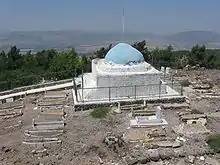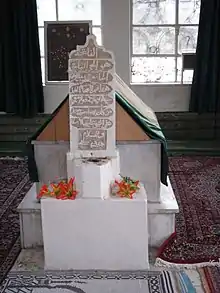Dihyah bin Khalifah al-Kalbi | |
|---|---|
دِحْيَة ٱبْن خَلِيفَة ٱلْكَلْبِيّ | |
 Maqam of Nabi Dahi, dedicated to Dihyah al-Kalbi at Givat HaMoreh |
Dihya ibn Khalifa al-Kalbi (Arabic: دِحْيَة ٱبْن خَلِيفَة ٱلْكَلْبِيّ, Diḥya al-Kalbī), sometimes spelled Dahyah, was the envoy who delivered the Islamic prophet Muhammad's message to the Roman Emperor Heraclius.[1]
According to Muhammad's wife Aisha, he saw Jibril twice “in the form that he was created” and on other occasions as a man resembling Dihya ibn Khalifa al-Kalbi, an extraordinarily handsome disciple of Muhammad.
Two similar narrations have been recorded through Abu Uthman in Sahih al-Bukhari that reports an incident witnessed by Muhammad's wife Umm Salama:
A hadith attributed to Abu 'Uthman reports:[2]
A hadith attributed to Abu 'Uthman reports:[3]
Expedition of Zaid ibn Harithah (Hisma)
He was attacked during the Expedition of Zayd ibn Harithah (Hisma) Dihya approached the Banu Dubayb (a tribe which converted to Islam and had good relations with Muslims) for help. When the news reached Muhammad, he immediately dispatched Zayd ibn Harithah with 500 men to punish them. The Muslim army fought with Banu Judham, killed several of them (inflicting heavy casualties), including their chief, Al-Hunayd ibn Arid and his son, and captured 1000 camels, 5000 of their cattle and a 100 women and boys. The chief of the Banu Judham who had embraced Islam appealed to Muhammad to release his fellow tribesmen, and Muhammad released them.[4][5]
Death and descendants
See also
References
- ↑ "Chapter 42: The Events of the Seventh Year of Migration". Archived from the original on 2000-12-10. Retrieved 2008-04-29.
- ↑ USC "Religious Texts" Archived 2011-08-23 at the Wayback Machine, Sahih al-Bukhari, Retrieved on 2009-4-11.
- ↑ USC "Religious Texts" Archived 2008-12-05 at the Wayback Machine, Sahih al-Bukhari, Retrieved on 2009-4-11.
- ↑ Mubarakpuri, Saifur Rahman Al (2005), The Sealed Nectar, Darussalam Publications, p. 226, ISBN 9798694145923 (online)
- ↑ Watt, W. Montgomery (1956). Muhammad at Medina. Oxford University Press. p. 108. ISBN 978-0-19-577307-1.
Dihyah b. Khalifah al-Kalbi, who had gone to Syria on an errand for Muhammad, was returning to Medina with gifts, when he was robbed by a man of Judham called al-Hunayd. Another clan of Judham, however, or some men from anothertribe, forced al-Hunayd to give the things back. Meanwhile a leader of Judham, Rifa'ah b. Zayd, had been in Medina, had brought back to the tribe Muhammad's terms for an alliance, and the tribe had accepted. Muhammad had not been informed of this decision, however, and sent out Zayd b. Harithah to avenge the insult to his messenger. There was a skirmish in which the Muslims killed al-Hunayd and captured a number of women and animals.
(free online) - ↑ "Dihya al-Kalbi (sahabi d. 45 H. in Damascus)". damas-original.nur.nu.
